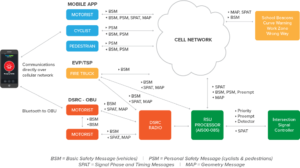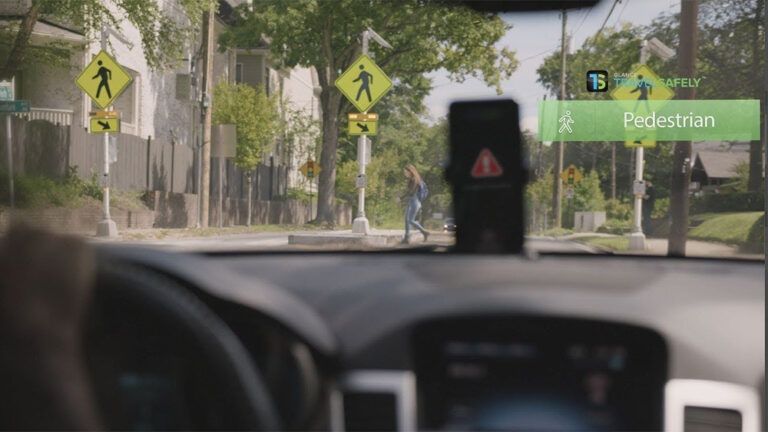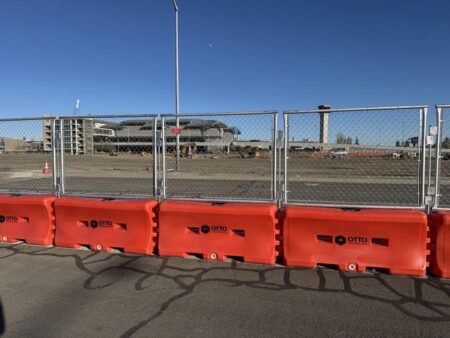At last week’s Consumer Electronics Show (CES 2020) in Las Vegas, connected intelligent transportation systems and infrastructure developer, Applied Information Inc. (AII), unveiled its latest ‘hybrid’ roadside infrastructure communications unit (RSU) featuring the new 9150 cellular vehicle-to-everything (C-V2X) chipset from Qualcomm Technologies Inc.
The configurable AI-500-095 Dual-Mode RSU with the 9150 C-V2X chipset provides direct communication of Signal Phase and Timing (SPaT) and Basic Safety Messages (BSMs) to equipped vehicles and smartphones. The product also provides redundant communication via the cellular network and other customer-specified pathways. The addition of the 9150 C-V2X chipsets as part of Applied Information’s products gives roadway operators a single solution to support signal pre-emption for first responders, signal priority to transit buses, and safety messages to drivers and autonomous vehicles. The technology also provides roadway operators with a platform upon which to create additional applications for alerts and warnings for school zone safety, work zone safety, special event traffic management and public safety.
C-V2X connected infrastructure applications supported by the AI-500-095 Dual-Mode RSU include:
- Traffic signals;
- Emergency vehicle traffic signal pre-emption;
- Transit bus traffic signal priority;
- School zone flashing beacons;
- Changeable message signs;
- Work zone safety.
The new RSU is fully-compatible with Applied Information’s Glance Smart City Supervisory platform that enables cities to manage all their traffic and ITS assets on one web-based application. It can also supply information for AII’s free TravelSafely smartphone app that connects drivers, cyclists, and pedestrians, and the transportation infrastructure for a safer mobility experience. Deployments of the AI-500-095 Dual-Mode C-V2X RSU are currently underway on projects in Georgia and Texas.
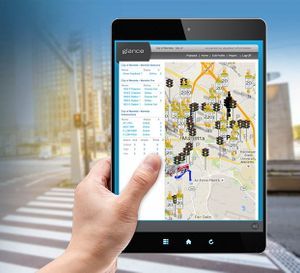 As a global solution for transportation communications, C-V2X is designed to improve automotive safety, traffic efficiency, and automated driving with its low latency communications, allowing vehicles to communicate directly with other vehicles, pedestrians, and roadside infrastructure without the involvement of a cellular network or network subscription. The technology also enables emergency vehicles to get green lights in the direction of travel while safely bringing all other traffic to a halt, as well as alerting drivers to road conditions and other hazards even when there is no visibility. With a strong evolution path in 3GPP to 5G New Radio (5G NR), C-V2X will offer the performance and support connected vehicles need to communicate with transportation infrastructure, leading to less congestion, reduced emissions and a smoother driving experience.
As a global solution for transportation communications, C-V2X is designed to improve automotive safety, traffic efficiency, and automated driving with its low latency communications, allowing vehicles to communicate directly with other vehicles, pedestrians, and roadside infrastructure without the involvement of a cellular network or network subscription. The technology also enables emergency vehicles to get green lights in the direction of travel while safely bringing all other traffic to a halt, as well as alerting drivers to road conditions and other hazards even when there is no visibility. With a strong evolution path in 3GPP to 5G New Radio (5G NR), C-V2X will offer the performance and support connected vehicles need to communicate with transportation infrastructure, leading to less congestion, reduced emissions and a smoother driving experience.
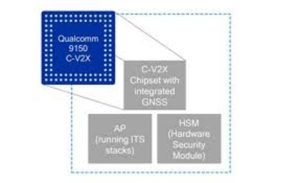 “The infrastructure plays a critical role in leading the way for widespread adoption and deployment of connected vehicle technology with all its benefits of improved safety and efficiency,” said Bryan Mulligan, Applied Information’s president. “Working with Qualcomm Technologies provides roadway operators with the confidence to deploy today and be ready for new applications and advances in communications in the future.”
“The infrastructure plays a critical role in leading the way for widespread adoption and deployment of connected vehicle technology with all its benefits of improved safety and efficiency,” said Bryan Mulligan, Applied Information’s president. “Working with Qualcomm Technologies provides roadway operators with the confidence to deploy today and be ready for new applications and advances in communications in the future.”
Jim Misener, senior director for product management at Qualcomm Technologies, commented, “With the deployment of C-V2X technology accelerating, vehicle-to-everything communications will be a cornerstone of improved road and public safety, especially as autonomous systems gain traction. Working with Applied Information to develop an advanced C-V2X system will realise the potential of mobility innovation, and address complex safety challenges automakers are pursuing.”